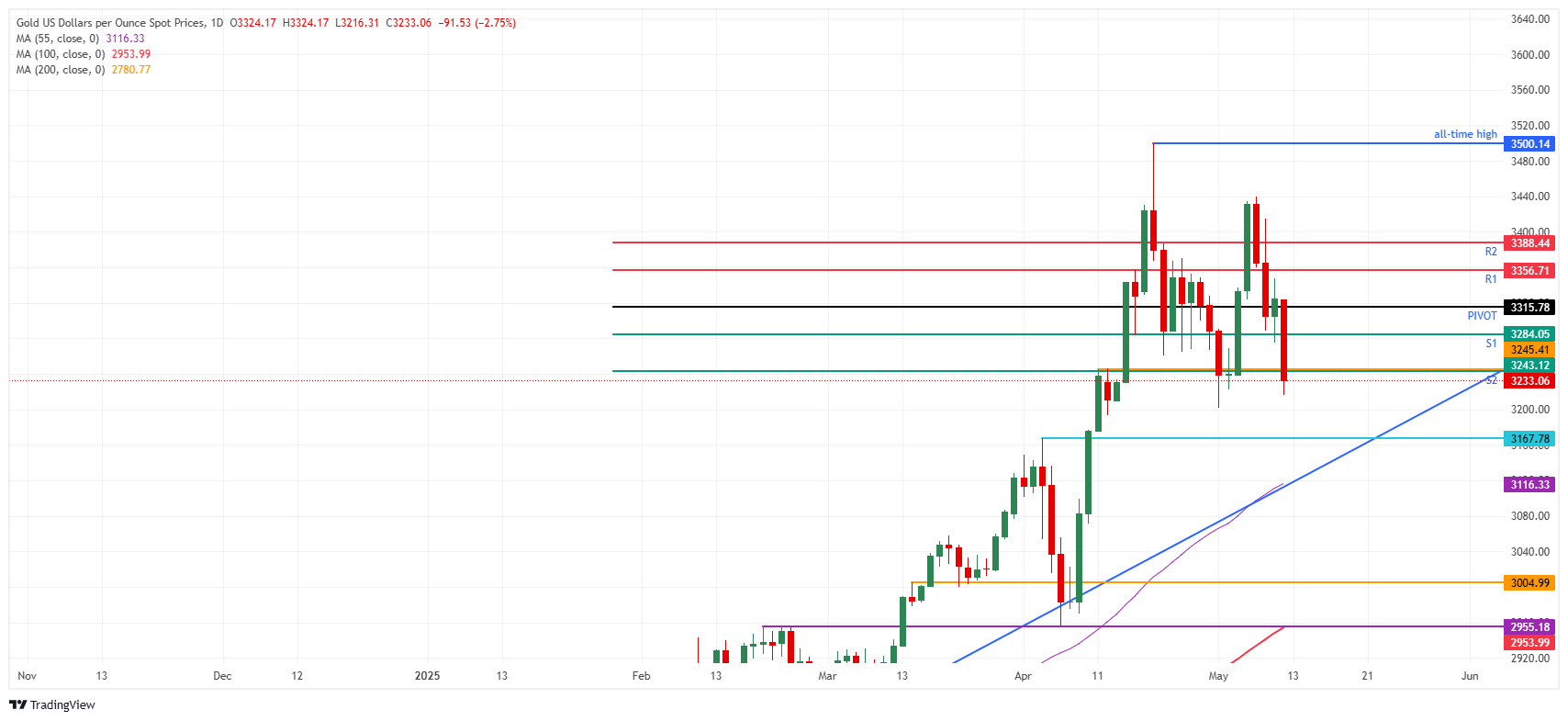- Gold price sinks as the US and China agree to a major reduction in tariffs for 90 days..
- China will lower its tariffs on US goods to 10% from 125%, while the US will do so to 30% from 145%.
- Safe-haven outflows lead Gold to test vital supports before technically ending the rally.
Gold (XAU/USD) sinks more than 2.5% at the start of the European trading session and heads towards $3,233 at the time of writing as the talks between the US and China have brought some low-hanging fruit for the equity markets. China has agreed to lower its tariffs on the United States (US) to 10% from the initial 125%, while the US will lower its tariffs on China to 30% from 145%, both for 90 days. The announcement caused a risk-on wave in markets, with investors fleeing from safe-haven assets such as Gold.
US President Donald Trump on Friday already hinted at the possibility that the talks could be productive and issued a general message to “buy stocks now” on his Truth Social Network. In this context, Gold has already lost nearly 8% from its all-time high at $3,500 reached on April 21
Daily digest market movers: Spill over shock
- The US-China deal to temporarily remove tariffs has sent shockwaves in financial markets: US yields are climbing higher, with the US 10-year yield hitting 4.43%, a level not seen since the beginning of April. Expectations are that a surge in demand on the back of this tariff relief could lead to a spike in inflation.
- In the commodity space, Oil is rocketing higher by more than 2% to $62.50 at the time of writing, as demand is expected to pick up again as trade tensions ease.
- Equities are also surging, with Chinese stocks rallying over 1%. European stock indices see milder gains, while US futures are outperforming with gains between 2.50% and 3%.
- US Treasury Secretary Scott Bessent said that “neither the US nor China wants to decouple” and that he would like to see China open its market more to US goods. A possibility for a purchasing agreement is possible, Bessent went on to say in the statement, Bloomberg reports.
Gold Price Technical Analysis: Don’t catch a falling knife
Time to roll up your tents and clear the field for the safe-haven outflow avalanche that will likely take place on Monday. Expectations are that a second wave of selling could take place once the US session comes online. It is not unlikely that, with the amassed selling orders, prices could drop below $3,200 soon.
Should this occur, the pressure is on both the S2 support and that technical pivotal level at $3,245 coinciding. Once that level snaps, look for a substantial leg lower, below $3,200, towards $3,167. With that move, nearly all gains from April and May would be erased.
Looking up, a whole list of levels need to be reclaimed in its recovery to retest the all time high at $3,500. First the daily S1 support (which is now a resistance) at $3,284 needs to be achieved. The daily pivot at $3,315 is up next, followed by the R1 resistance around $3,356 and the R2 up next at $3,388.

XAU/USD: Daily Chart
Gold FAQs
Gold has played a key role in human’s history as it has been widely used as a store of value and medium of exchange. Currently, apart from its shine and usage for jewelry, the precious metal is widely seen as a safe-haven asset, meaning that it is considered a good investment during turbulent times. Gold is also widely seen as a hedge against inflation and against depreciating currencies as it doesn’t rely on any specific issuer or government.
Central banks are the biggest Gold holders. In their aim to support their currencies in turbulent times, central banks tend to diversify their reserves and buy Gold to improve the perceived strength of the economy and the currency. High Gold reserves can be a source of trust for a country’s solvency. Central banks added 1,136 tonnes of Gold worth around $70 billion to their reserves in 2022, according to data from the World Gold Council. This is the highest yearly purchase since records began. Central banks from emerging economies such as China, India and Turkey are quickly increasing their Gold reserves.
Gold has an inverse correlation with the US Dollar and US Treasuries, which are both major reserve and safe-haven assets. When the Dollar depreciates, Gold tends to rise, enabling investors and central banks to diversify their assets in turbulent times. Gold is also inversely correlated with risk assets. A rally in the stock market tends to weaken Gold price, while sell-offs in riskier markets tend to favor the precious metal.
The price can move due to a wide range of factors. Geopolitical instability or fears of a deep recession can quickly make Gold price escalate due to its safe-haven status. As a yield-less asset, Gold tends to rise with lower interest rates, while higher cost of money usually weighs down on the yellow metal. Still, most moves depend on how the US Dollar (USD) behaves as the asset is priced in dollars (XAU/USD). A strong Dollar tends to keep the price of Gold controlled, whereas a weaker Dollar is likely to push Gold prices up.

